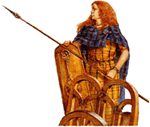

Very
quickly Boudicca
raised an army of loyal supporters and they
set off South towards
the Roman town
of
Colchester
It is over 1,200 years since the Romans left England but during their time here they built great roads, villas and fortifications. They also had many battles with the warrior celtic tribes that inhabited Britain. The most famous of these Celtic Warriors was Queen Boudicca from East Anglia and the tales of her march through Suffolk and Essex on her way to attack London, the centre of Roman power, are now the stuff of legend.
England has produced many fierce,
warriors down the ages who have fought to keep England free, but there
was one formidable lady in history whose name will never be forgotten
-
At the time of the Roman conquest of southern Britain Queen Boudicca ruled the Iceni tribe of East Anglia alongside her husband King Prasutagus.
Boudicca
was a striking looking woman. -
The trouble started when Prasutagus,
hoping to curry favour with the Romans, made the Roman Emperor Nero
co-
But no! Unfortunately the Roman Governor of Britain at that time was Suetonius Paulinus who had other ideas. After Prasutagus's death his lands and household were plundered by the Roman officers.
Not content with taking all the property and lands, Suetonius had Prasutagus' widow Boudicca publicly flogged and her daughters brutally attacked by Roman slaves! Other Iceni chiefs suffered in a like manner and their families treated like slaves.
Queen Boudicca was outraged by this treatment and swore an oath that she would make the Romans pay for their behaviour.
On the way Boudicca and her growing band of supporters destroyed any Roman outpost they found and anyone who was known to be a Roman sympathiser.
As she moved South, Boudicca enlisted men from towns and villages on her way so that by the time she reached Colchester she had an army under her control. She now attacked Colchester and destroyed the Roman garrison there. The Romans were completely unprepared for the attack as the bulk of their troops were off in Wales fighting a battle.
Flushed with this success Boudicca now moved off West towards London. Records of the day indicate she may well have come through Clare and Haverhill rallying her troops and gathering more men on the way.
When finally she reached London her army found the Roman garrison had fled after hearing of the destruction of Colchester. Her army fell on the town like a storm, destroying everything in sight and slaughtering the inhabitants.
Her army showed no mercy and after leaving the town in ruins Boudicca headed north west towards St Albans another Roman town.
When word of the slaughter reached the Roman generals even they were horrified at the destruction. They decided to march their army into England for a final battle. The two armies met at a site south of modern day birmingham.

"She
was huge of frame,
terrifying of aspect, and with a harsh voice.
A great mass of bright red hair fell to her
knees: she wore a twisted torc, and a tunic of many colours, over which
was a thick mantle, fastened by a brooch. Now she grasped a spear, to
strike fear into all who watched her."
Roman historian Dio Cassius describing Queen Boudicca
THE FINAL STAND
The Roman historian Tacitus in his 'Annals of Rome' gives a very vivid account of the final battle, which was fought in the Midlands of England, near Nuneaton, in AD61.
“Boudicca and her daughters drove round in her chariot to all her tribes before the battle, exhorting them to be brave. She cried that she was descended from mighty men but she was fighting as an ordinary person for her lost freedom, her bruised body and outraged daughters. Perhaps as taunt to the men in her ranks, it is said that she asked them to consider: 'Win the battle or perish: that is what I, a woman will do; you men can live on in slavery if that's what you want.'’
To ensure success the Roman cavalry was released which promptly encircled the enemy and began their slaughter from the rear. Seemingly mad with blood lust, Tacitus records that 80,000 Britons; men, women and children, were killed. The Roman losses amounted to 400 dead with a slightly larger number wounded.
Boudica was not killed in the battle but took poison rather than be taken alive by the Romans.
Boudica’s rebellion ultimately failed but she has secured a special place in British folk history and is remembered for her courage; The Warrior Queen who fought the might of Rome. And in a way she did get her revenge, as in 1902 a bronze statue of her riding high in her chariot, designed by Thomas Thorneycroft, was placed on the Thames embankment next to the Houses of Parliament in the old Roman capital of Britain, Londinium.